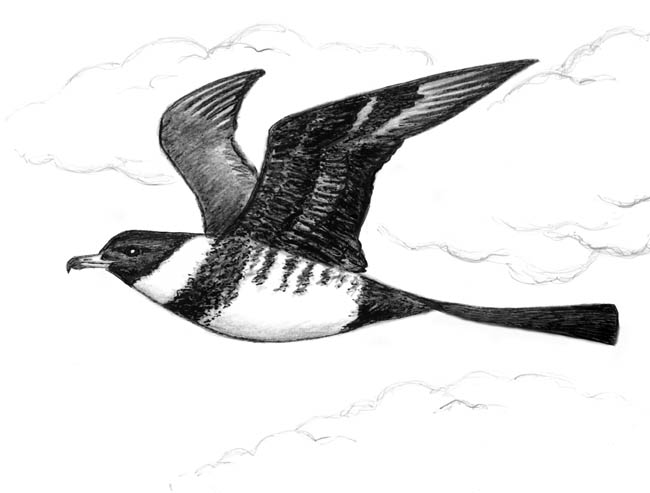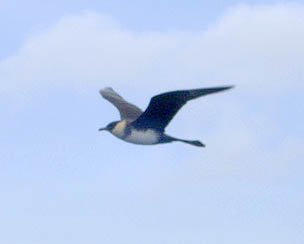
Dear Bird Folks,
We saw this beautiful bird (see attached photo) while we were fishing off the coast of Sandwich, in Cape Cod Bay. None of us have ever seen this species before, but we think it might be a jaeger. Thanks for any info you can offer.
– Melynda, Buzzards Bay, MA

I’m jealous, Melynda,
Over the years I’ve done a fair bit of traveling to see birds. I’ve seen penguins in New Zealand, emus in Australia, macaws in Costa Rica, Nenes in Hawaii and have driven all night just to see a singing crow. (It was Sheryl Crow, but it still counts.) However, I’ve never seen a jaeger and I probably never will. Jaegers spend most of their lives out at sea and since I’m extremely prone to seasickness, I avoid getting into boats, any kind of boats. I don’t go on cruise ships and I don’t go whale watching. I won’t even watch Gilligan’s Island or shop in Old Navy. I think I’ve made my point.
The bird in your photo is indeed a jaeger, a Pomarine Jaeger, to be exact. And while I admit that I’ve never seen a wild jaeger, I’d bet most people reading this have never even heard of this bird. In fact, right now I envision many folks have stopped reading this column altogether and have moved on to this week’s yard sale postings. Who wants to read about a bird they’ve never heard of? Oh, come on. It won’t be that bad. At least it’s better than reading about the proper solution for hummingbird food (four parts water to one part sugar) for the gazillionth time. I think I’ve made my point.
To begin with, jaeger is pronounced “yay-ger,” as in test pilot, Chuck Yeager. (They also should not be confused with the Pomeranian Jaeger, an annoying, yapping little bird.) To most observers jaegers probably appear to be dark, chunky gulls. But unlike “seagulls,” which ironically don’t spend much time out at sea, jaegers love the open ocean. It’s their favorite place to be. There are three species of jaegers in the world and all three of them can be seen in the waters off Cape Cod. Of the three, the Pomarine Jaeger is the largest and probably the most interesting. They are beautiful birds, with dark bodies and white and yellowish neck-collars. One odd feature of these birds is their tail feathers. Instead of lying flat, like the tails of most other birds, the jaeger’s tail is vertical, like the tail of a fish or one of those great white sharks that are making local beach goers nervous.
Even though jaegers are seabirds, they eventually have to move inland if they want to have baby jaegers. But while most seabirds depend on a steady supply of fish in order to have a successful breeding season, this is not the case with Pomarine Jaegers. The main food item is, of all things, lemmings. Lemmings are so important to these birds that they won’t even bother laying eggs if the lemming supply is too low. Each spring the birds make the long journey to the Arctic tundra. But if they don’t see any lemmings, they don’t stay. Even though they are all fired up to breed, without an available food supply, there is little else the birds can do…except take a cold shower and turn around and head back to the ocean.
Being reliant on lemmings is not unique to Pomarine Jaegers. Other birds, most notably Snowy Owls, also depend upon lemmings. We expect owls to eat small mammals, but seabirds? Well, Pomarine Jaegers are not typical seabirds. They are large, powerful and fearless. Like the owls, jaegers scan the tundra and look for signs of lemming activity. But unlike owls, jaegers can’t capture prey with their talons, because they don’t have any. Like most seabirds they have flimsy, little webbed feet. So instead of using talons, they catch lemmings with their strong beaks. Occasionally, lemmings try to avoid the jaegers by hiding underground. That doesn’t help. Pomarine Jaegers are the only birds in the world that will actually dig into soil to extract a hiding lemming. Once caught, it’s only a matter of seconds before the yummy lemming is down the hatch and headed for a one-way trip to Gizzardland.
In the open ocean, away from their Arctic breeding grounds, Pomarine Jaegers feed by plucking small marine creatures out of the water or by chowing down on the fish guts discarded from fishing boats. If for some reason the jaegers can’t catch enough of their own food, they have a backup plan. They steal. As I said earlier, jaegers are strong and powerful birds. They can easily overtake other seabirds and bully them into spitting up their dinners. (Hmm. Spit-up fish guts. Now that’s a meal worth fighting for.)
You might not know this, Melynda, but your photo of the Pomarine Jaeger is one of the best I’ve ever seen. It showed the bird’s field marks perfectly. Your photo even showed the bird’s weird twisted, shark-tail. That’s not an easy shot to get since the birds only have this feature for a few weeks during the breeding season. Your excellent photo has made me change my mind about going bird watching on boats. I’ve decided to face my fears. I just read about a boating trip where they guarantee everyone will see a flock of enormous white birds. So next week I’m going to Boston, and if the weather is calm, I’ll attempt to ride on one of those swan boats in the Public Gardens. Wish me luck.